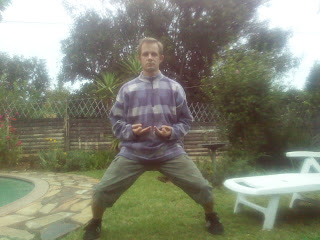Force Training- Conditioning Exercises
"Hard" styles of martial arts like Karate and Muay Thai are known to condition the body's weapons by striking wooden poles, punching bags and the "makiwara"(a striking post with a thick rope, straw mat or cushion stuffed with sand attached to it). These methods are effective in conditioning the palms, fists and feet. These exercises harden the bones of the impact area. The muscles of the torso can also be toughened by repeated punching and striking. I just want to state that patience is necessary and that the object is to see how hard you can be hit without injury. Simply injuring yourself from the start serves no purpose. The object is rather to use your mind to strengthen your body. A simple experiment will illustrate the principle that applies here: When you are able to channel your qi, summon your qi to flow through your entire body. Feel your stomach's muscles become hard like steel. Now- maintaining this feeling of power- punch yourself in the st...

